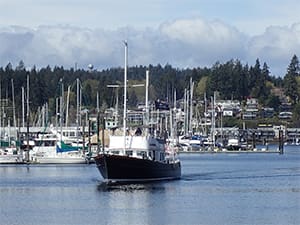“One if by land, two if by sea.” We have all heard that phrase before. It’s a rallying call more than 150 years old, and I believe it also applies to distance cruisers heading offshore. When you are on land, one is typically enough of most things because you can easily acquire a replacement. When you travel out of the sight of land, you can’t easily reload. So, you need to consider reliable, original equipment and understand self-sufficiency before you ship out. Critical spares need to be organized for quick retrieval and easy installation.
Of course, all boats have a finite amount of space. Unlike the biblical story of Noah and the pairs of animals he set out to sea with, you may not have the benefit of divine inspiration and therefore should give some forethought to what you really need to carry with you as backups. You can’t store two of everything, so some careful thought needs to be given to essentials — what could break that would leave you dead in the water or ruin your trip?
I know many distance cruisers who travel with an extensive inventory of spare parts. They have everything cataloged and know where it is stored. They also make sure to seal the typical cardboard packaging with clear plastic so that moisture will not damage the contents and it is visually easy to find if you are sorting through a storage bin.
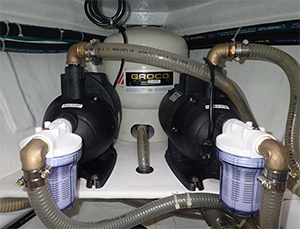 |
|
Two fresh water pumps adds redundancy. |
It’s hard for me to say what you will need to double up on; it can get expensive. Redundancy is a necessity, but you may not know what you need to double down on. It’s not an easy decision to decide what you can’t do without, and experience can be a harsh teacher.
Below is a summary list of some of the key features and components that I believe will create the biggest impact if they fail. Please consider this a starting guide with the hope that it will get you thinking about other possibilities and priorities specific to your boat.
Diesel fuel
Fuel is the lifeblood of a trawler. Good, clean fuel and well-maintained engines and generators give us the propulsion we need to explore and the electricity we require for charging batteries, running air conditioners, etc. Before taking off on a long trip, you should verify your tanks are clean, fuel lines are unrestricted and manifolds have their valves clearly labeled. These preparations may help avoid a shutdown due to dirty fuel or operator error.
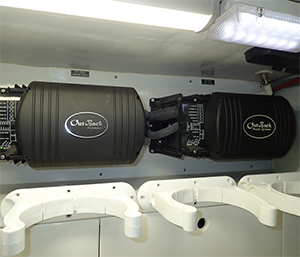 |
|
This vessel has twin inverters. Should one fail, AC-powered devices can be run from the other unit. |
It is common on modern builds to have a Racor dual fuel filter/water separator on the main engine’s supply side. These are plumbed in and easy to watch for clogged filters — you can tell by monitoring the vacuum gauge — and you can simply switch over to the other side and replace the dirty cartridge element. Some owners also plumb their diesel supply to generators with dual Racors, a smart thing to consider along with having the spare elements on board and knowing how to change them out.
Fresh water
Fresh water is an essential. Surprisingly few cruisers have a backup fresh water pump, leaving perfectly good water trapped in the tanks without means to dispense it. I view a spare pump as a must; better yet, have the second pump pre-plumbed so that if you have a failure, you can easily cross over from the bad pump to the good one by switching valves. This is easier than finding the replacement part, disconnecting the bad pump and then plugging in the new one.
Cruisers who travel remotely know that watermakers provide the ultimate independence. On larger trawlers, it is becoming more and more popular to have two watermakers. When you have two of something like this, it is important to create a schedule so that you consistently go back and forth between the units and keep both active. Anything that sits idle has a better chance of giving up when needed, and by using both you will remain familiar with their operations.
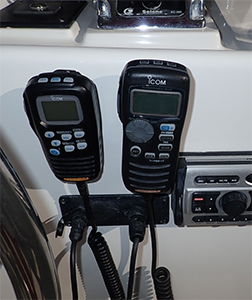 |
|
Doubling up on VHF radios not only provides a backup in case of failure but allows you to monitor two channels as well. |
Electricity
Most trawlers have 12-volt navigation and communications electronics. Do you have a separate charger to keep your 12-volt bank ready? I’ve seen many trawlers with two generators, two inverters (including bypasses), two battery chargers and upgraded battery banks to ensure there is always adequate electricity available.
Toilets
Toilets are a subject that should be mentioned. I don’t know any cruisers who sail with a spare head (hey, two heads are better than one, but typically they are both installed). So, what is the common failure point? Check out the instruction manual and look for serviceable replaceable parts. Knowing what could create an issue is extremely important. A small plastic joker valve (a relatively inexpensive plastic part), if fouled, could clog the flushing function. Having a spare joker valve and the tools to change one out can make life much more pleasant on board.
Communications
Communications with other ships is primarily done by VHF radio, and it is a requirement to remain tuned to VHF channel 16. Having two VHF radios allows you to keep track of ship-to-ship radio traffic by monitoring channel 16 while also being able to listen in or communicate with the second unit. Since the cost is affordable, many trawler owners keep a second — ideally, waterproof — handheld for this purpose, and also have it ready for use aboard the ship’s tender or as emergency gear to include in the ditch bag if they need to abandon ship.
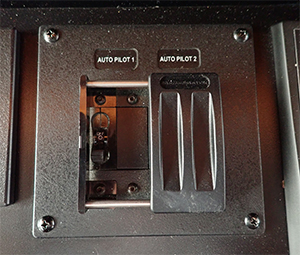 |
|
Perhaps twin autopilots are not necessary for short coastal hops, but they can come in handy in case of failure on offshore trips. |
Navigation
The ultimate backup is a paper chart. We have all become so reliant on digital charting that we have forgotten about the basics. If your trawler is struck by lightning, for example, you could lose all of your electronic nav/com, making paper charts a worthy consideration. I’d also recommend that you have more than one form of electronic charting. The quality of digital charting apps on tablets and smartphones using GPS is amazing. Consider keeping a backup laptop loaded and ready to perform if your primary takes a coffee bath!
Steering
Steering by hand is incredibly tiring on a long passage. Nearly all cruisers rely on their autopilot to do this task. What if your autopilot fails? Having two autopilots is a smart move. I know many trawler owners with two pilots who will configure the parameters for the two most common sea conditions: running uphill into the seas and running downhill with following seas. Write down the settings or record them digitally so you can quickly reset one pilot if the other fails. Do you have an emergency tiller? What if you lose all of your hydraulic oil? How will you steer your emergency tiller? Welding bails on the controlling end of the tiller will allow you to attach block and tackle rigging to maintain control of an extremely powerful lever that truly cannot be hand-steered in big seas.
Lighting
LED lights, spare bulbs for running offshore and a flashlight at every door are all good ideas. Nighttime requires convenient lighting; consider red lenses, and think about night vision as your eyes adjust to the darkness. Do you want to change out running light bulbs at night in a rough sea? What about upgrading all of your running lights to LED? Installing LED lighting may be a more logical improvement, rather than relying on spares.
Bilge pumps
Do you have both manual and electric bilge pumps? How do your bilges connect? Do you have an alarm when they come on automatically? Does your electric bilge pump have a strainer you need to clean out? What about a high-water bilge pump? What will you do in an emergency if you are holed? Do you have a “crash pump” aboard that could get water out of your hull faster than it is coming in? These are all important questions to consider when outfitting your trawler with spares.
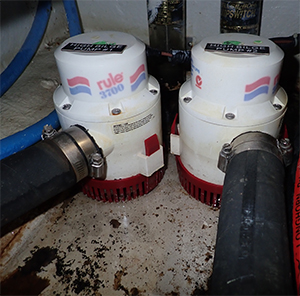 |
|
The desirability of having a backup bilge pump needs no further explanation. It could help save the boat in case of a leak. |
As the saying goes, use it or lose it: If you are set up to operate a replacement, remember to put it into service occasionally so you know it is fully functioning and ready to go. Some ocean-crossing trawlers have wing (auxiliary) engines, which are installed to allow you to “get home” if your main fails. But, if you never exercise it and are expecting it to just turn over and come to life after sitting dormant for years, you may be in for a terrible surprise.
Many owners feel safer knowing they have a game plan for the unexpected, but it is simply not practical to carry two of everything aboard. When you run out of something or when a part stops working, you can often find a workaround.
No one is ever truly a “Noah-it-all.” It’s nearly impossible to anticipate every eventuality, but this is a preparation mindset active cruisers strive for.
Jeff Merrill, CPYB, is the president of Jeff Merrill Yacht Sales, Inc.- www.JMYS.com. He is a veteran yacht broker who provides individual attention and worldwide professional representation to buyers and sellers of premium brand, oceangoing trawlers. Merrill is active in the cruising community as a public speaker and writer and enjoys spending time at sea with clients. Jeff has written several articles for Ocean Navigator’s Power Voyaging column and is constantly looking for new ideas to improve and simplify the trawler lifestyle. If you have a suggestion or want to get in touch, please email Merrill at Jeff.Merrill@JMYS.com.

